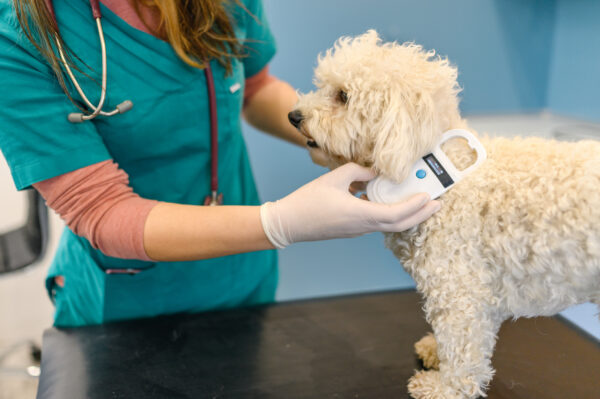What types of dog and cat skin allergies are there? Why is my pet itching? Can they get hay fever, too? If you’ve ever found yourself asking these questions, you’re not alone. We caught up with our resident vet to advise you of the three most common dog and cat allergies, their likely causes, and the steps you should take to overcome any allergic reactions.
1. Fleas
A flea allergy – medically known as flea allergy dermatitis – flares up in the event of flea bites. The specific aggravator for a flea allergy is flea saliva. Other insect bites can cause dog and cat allergic reactions too, but flea saliva is by far the most common. If you spot your pet losing hair around the base of their tail, continually biting and scratching at their skin, or developing an inflamed skin rash (a ‘hotspot’) or hives (bumps that spontaneously appear), your four-legged friend may have a flea allergy.
Scratching and biting at their skin rash can lead to other health issues, such as yeast or bacterial infections – making it all the more important to seek the attention of a vet. Protecting your pet from fleas should be part and parcel of pet parenthood, but this rings especially true when a flea allergy is brought into the equation. Your vet will be able to help you swat up on how to prevent fleas, how to spot fleas hidden in dog fur, and how to get rid of fleas – both from your pets and your home. Remember to deworm your pet if they’ve had fleas, as fleas also carry tapeworm eggs – and worms can be a cause of skin allergies, too.
2. Environmental factors
Be it dust, pollen, or mould, dog and cat allergies can flare up at any point in the year. Seasonal allergies are just as common amongst our furry friends as they are with us humans. Yes, a dog allergic to grass is a genuine sensitivity that can cause skin rashes and dog hives. Having said that, the summertime can be especially tricky when it comes to dog and cat hay fever.
If your pet is experiencing swelling and/or redness of the face, throat, lips, eyelids, and/or earflaps, this could be a sign of an allergic reaction. You should pay a visit to your vet with your furry pal in tow. They may prescribe a medication such as antihistamines, steroids or immunomodulators in order to control your pet’s symptoms.
3. Food intolerances
Not many dogs and cats suffer from true food allergies. Instead, they have food intolerances or food sensitivities. This kind of allergic reaction is a gradual one (rather than an instant immune response) to a particular ingredient (or ingredients) in their food. A dog allergic to chicken is not unheard of. In fact, the most common food sensitivities are seen in different types of protein – be that chicken, beef, grains, eggs, or milk. Itchy eyes, ears, and paws are all symptoms of a food allergy, along with gastrointestinal issues (we’re talking diarrhoea and constipation).
Some of the best foods for skin allergies are hypoallergenic pet foods, which exclude common allergens and usually contain a single protein. Feeding a “novel” protein diet means feeding a protein that your pet’s immune system is unlikely to have been exposed to. Common examples of this are duck and venison.
If you think your pet might have an allergy
• Consult with your vet to ensure that it is an allergy and not something else entirely, such as mange or even a medical problem like hypothyroidism or Cushing’s disease.
• If your vet suspects your pet’s symptoms are due to an allergy, they may suggest a medical treatment as a first line. Discuss the various options available, including topical and injectables.
• Avoid the cause of the allergy where possible – be it flea bites, a specific ingredient causing a food intolerance, or environmental factors such as grass.
• Similar to human allergy testing, dog and cat allergy testing is possible using a blood sample or skin tests. This is often quite complicated due to the complexity of the immune system. This means it may not always pinpoint the exact cause of the allergy, especially when it comes to food.
• If your pet has a severe allergic reaction and goes into anaphylactic shock, you must take them to an emergency veterinary clinic.
• Be patient. Skin problems are probably the most frustrating symptom to treat for vets. Work through the process with your vet step by step, as it can sometimes take months or even years to control skin allergies in animals. There is hope, though!
Our articles are not a replacement for face-to-face vet advice. Consult with your vet regularly to raise any concerns that you may have.



